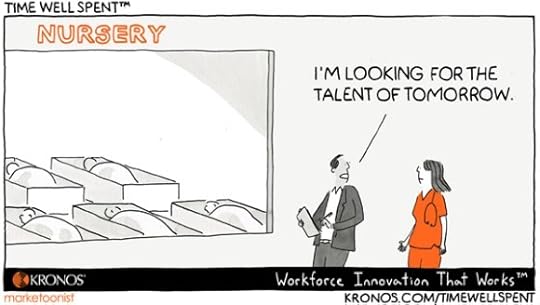Sharlyn J. Lauby's Blog, page 147
November 13, 2016
LinkedIn Endorsements: User Profiles Receive 17 Times More Views
A few weeks ago, I shared an infographic from LinkedIn which basically said, “Everyone is looking for a new opportunity.” If that’s true, and I have no reason to believe it’s not, then keeping your brand relevant is important. For example, your LinkedIn profile should always be current. That’s one of the ways recruiters and hiring managers can find you.
In case you missed it, LinkedIn announced some changes to their endorsements feature. We did a post here on HR Bartender a couple of years ago about endorsements – why they’re important and how to use them. It’s possible that endorsements might have fallen off your radar, so I asked Yolanda Yeh, product manager at LinkedIn, to give us an update on what’s happening with endorsements.
Yolanda, let’s start with a brief overview of endorsements – what are they, how many people use them, etc.?
[Yeh] The goal of endorsements is to provide a way for your LinkedIn connections to recognize you for your skills and expertise. Since 2012, more than 10 billion endorsements have been shared by LinkedIn members’ connections for skills that range from leadership to machine learning.
The skills and endorsements on your profile help others understand your strengths, and help you get discovered through search. People with at least five skills listed on their LinkedIn profile receive up to 17 times more profile views. When viewers (like hiring managers or recruiters) see that you’ve been endorsed for those skills, it helps you put your best foot forward.
Now that we’ve been using endorsements for a while, what has LinkedIn discovered? Are endorsements being used exactly the way LinkedIn anticipated? Any nice surprises that you didn’t think of?
 [Yeh] The goal of endorsements has always been to help members validate their strengths and expertise, and we’ve seen strong traction on this front.
[Yeh] The goal of endorsements has always been to help members validate their strengths and expertise, and we’ve seen strong traction on this front.
While many people on LinkedIn use endorsements, we realized that there was still more to do so we began to rethink the endorsements feature. Delivering endorsements that provide even more value required a blend of research, new machine learning models and re-architecting the backend infrastructure that both serves and recommends new endorsements. These changes to the “Skills & Endorsements” section means we can better surface the most relevant endorsements that help to validate your skills via “Featured Highlights,” and prompt endorsements based on how well a connection knows you and how well they know a skill.
We’ll continue to work on the endorsements feature to make it even more useful to our members in the future.
LinkedIn recently announced that, when recruiters view a candidate profile, they can view the endorsements of mutual connections. Two-part question here: First, if I’m a candidate, why is this new change important? And second, is there anything I should consider doing to my profile to take advantage of this change?
[Yeh] Being able to view the endorsements of mutual connections creates an immediate connection that helps you stand out: recruiters can see right away that people they know and trust have endorsed you for your work.
Which is why you should make sure your skills are up-to-date so that your connections can help you connect to opportunity. Also, check that your skills are listed in order of the strengths you want to highlight, so LinkedIn can help by targeting suggestions for those top skills.
The other new endorsement feature that LinkedIn rolled out is suggested endorsements. Tell us a little about it and how should I (as a LinkedIn user) look at these suggestions and use them appropriately?
[Yeh] We’ve improved targeting of suggestions to the people that best know the skill and person, so that the most relevant connections are giving endorsements. To best take advantage of this feature, members should list their skills in order of what they want to highlight, and continually refresh and update their skills as their role changes. We do the work of targeting endorsement suggestions for those skills.
My thanks to Yolanda for giving us the latest on LinkedIn endorsements. If you haven’t updated your profile lately, it might be time to make sure it reads the way you want it to. And if you want to stay up to date on using LinkedIn, be sure to read the LinkedIn blog.
The post LinkedIn Endorsements: User Profiles Receive 17 Times More Views appeared first on hr bartender.






November 11, 2016
Where Is the Talent of Tomorrow – Friday Distraction
(Editor’s Note: Today’s post is brought to you by our friends at Kronos, a global provider of workforce management and human capital management cloud solutions. For the second consecutive year, Great Place to Work has put Kronos on its list of the 50 Best Information Technology Companies to work for in India. Congratulations! And enjoy the post.)
“I’m looking for the talent of tomorrow.”
Truer words have never been spoken. One of the things I enjoy about the Time Well Spent cartoons from our friends at Kronos is the subtle humor regarding our profession. We know in human resources there are some “I’ve seen it all” moments. While there’s some humor in searching for talent in the local hospital nursery, there’s a tinge of reality that comes along with it.
I had lunch with a friend of mine in the executive search industry recently. He keeps asking the question, “Where are the next HR rock stars?” The question applies to many positions. I can see HR leaders being concerned about where they are going to find the next C-suite leader.
And frankly, that concern probably extends beyond the senior management team. Where’s the company’s next top salesperson? Or where is the next customer service guru – you know, the employee who customers ask for by name?
Recruiting is no longer a function that can wait for the job opening to occur or the signed requisition to show up. For organizations to hire the best talent, they must constantly be looking. And let me add that organizations need to start developing strategic partnerships with schools, colleges, associations, and professional groups. They need to show an interest in developing talent, not just hiring someone.
Finding the talent of tomorrow means planning and making investments today. Because candidates will remember the organization’s support. It’s positive brand recognition.
The post Where Is the Talent of Tomorrow – Friday Distraction appeared first on hr bartender.






November 10, 2016
8 Ways to Deliver Training that Employees Retain
The biggest concern organizations have when they invest in training is retention. By this, I mean having employees retain the material once they leave the class. No company wants to create a program and take employees out of the operation only to have the same issues occur repeatedly. It’s important for training programs to be designed and delivered in a way that increases retention of the content.
So how do we do that? Here are some things I’ve experienced that help employees retain the material:
Set expectations. Sessions that are required to end at a certain time can backfire. Instructors should not be required to talk for the sake of talking. Employees leave frustrated rather than motivated. Instead of holding people accountable for being in training for a specific amount of time; hold them accountable for the content.
Make the content relevant. I know this sounds like a no-brainer, but I’m amazed at the number of programs that aren’t practical and offer no takeaways. Today’s corporate training cannot be all theory. Programs need to give participants information about how to apply the information.
Use models to make a point. I believe participants like visuals. When you can use a visual to make a point, show a process, or demonstrate causality…do it. And give participants copies of it. Or let participants take pictures of it with their cellphones. It helps in the learning process.
Create engaging activities. Participants expect activities. Clarification: they expect a variety of activities. Having a full-day of training where the only activity is “discuss” isn’t enough variety. This puts some pressure on instructional designers, but if we want participants to be engaged, it’s necessary.
Take logistics seriously. I realize training isn’t about food and snacks, but the comfort of the room sets the stage for learning. Room temperature, chair comfort, refreshments all factor into the experience. Today’s participants expect WiFi, places to plug in their devices, and a comfortable place to sit. I always joke that the mind can absorb only what the rear can endure.
Deal with fidgeting. Let’s address the elephant in the room. Anyone who attends training is a busy person. They are not used to being in an all-day (or half-day) session. If you don’t give them something to occupy their hands, then they will reach for their phone. I love the fidget toys from Trainer’s Warehouse – inexpensive and effective!
Give participants the opportunity to practice. I’ve written before my POV on role plays but there are times when they must be utilized. There’s an old phrase “Telling isn’t training.” We can’t simply tell someone what to do and then say, “Do this when you’re back on the job.” That’s not training.
Tell participants how to use the information on the job. Speaking of practice, there’s a lot of relevant training that misses the debrief or takeaway moment. Training needs to include not only the knowledge but the application. The value is in the debrief. That’s the learning moment participants will take with them.
Classroom training programs are not dying or dead. They are however, facing higher expectations. Participants are willing to invest their time for training programs that are engaging and provide a takeaway.
Organizations want the same thing. When training is engaging, and offers a takeaway, employees learn. And they remember what they learn. This translates into a valuable investment. It’s all about the investment.
Image taken by Sharlyn Lauby after speaking at the Learning and Development League 2016 Annual Conference in Delhi, India
The post 8 Ways to Deliver Training that Employees Retain appeared first on hr bartender.






November 8, 2016
Should HR Be Autonomous From the Operation – Ask #HR Bartender
I’m sure you’ve seen articles – and we’ve written a few here – about the role of human resources. Today’s reader note wants to know about a different aspect of the role of human resources.
What’s your opinion on HR managers “directly” supervising a department within a company, where other departments in that organizational structure are autonomous from HR? I’m trying to understand the pros and cons of such an arrangement. I tried doing independent research on this issue, and in the process discovered your blog. Thank you for your time.
By definition, autonomy means “acting independently or having the freedom to do so.” Do I think that departments should act autonomously from HR? No. Do I think HR should act autonomously from the organization? No. Human resources and the other departments in the company need to work together to accomplish the company’s goals. People cannot simply go off and do whatever they wish. There are consequences to the business.
Now that being said, there are a couple of other words to consider: empowerment and accountability.
Should departments, including HR, be empowered to take care of certain tasks within the organization? Yes. Every decision doesn’t need to be a group decision. The organization should empower department leaders to handle certain problems and decisions. Department leaders should empower employees to take care of certain activities. If something outside of that agreed upon list of activities comes to surface, the group should figure out how to proceed in the short- and long-term.
Should HR and the rest of the organization hold themselves accountable for being fair, credible and trustworthy? Yes. Every individual and department within the company needs to garner respect. It’s the foundation for positive working relationships and company culture. Regardless of responsibilities, individuals must have the organization’s best interest as a priority. Otherwise, their credibility will suffer and the entire organization will feel the impact.
I know of several HR pros who also have responsibility for their company’s marketing department. It can make a lot of sense. But it takes working with the rest of the organization, using power positively, and being accountable.
The Intersection of #HR and Marketing
Every #HR Pro Should Own a Marketing Textbook
Can One Person Handle Both HR and Marketing
If Your Marketing Director Ran HR . . .
Human resources departments have a tough job. There are times when both management and employees want them to be objective and impartial. Where HR falls on the organizational chart is not the determining factor. I’m confident there are employees who would say their human resources department is biased and they don’t directly supervise another department. And there are employees who would say their HR department is fair and they do supervise another function.
The answer is whether or not employees have confidence that HR will be fair, transparent, and trustworthy.
Image taken by Sharlyn Lauby after attending the SHRM Annual Conference in Washington, DC
The post Should HR Be Autonomous From the Operation – Ask #HR Bartender appeared first on hr bartender.






November 6, 2016
Peer-to-Peer Feedback: An Opportunity to Activate Employee Performance
(Editor’s Note: Today’s post is brought to you by SilkRoad, a global leader in cloud-based talent activation solutions. At this year’s HR Technology Conference, they announced the availability of SilkRoad Agile Performance, a solution designed to help organizations activate employee performance with apps for check-ins, goals and reviews that maximize productivity, engagement and alignment with corporate objectives. Enjoy the post!)
As organizations continue to evaluate their performance management processes, one important consideration needs to be who is involved in the process. Of course, the employee and manager will be included, but you might want to add an employee’s peers as well.
Peer-to-peer feedback can be a welcome and valuable addition to the organization’s performance management process for several reasons:
Employees often have a different relationship with their peers (versus their manager). This isn’t to imply that one relationship is better or worse than another. It’s simply to say it’s different. In some cases, employees spend more time with their peers than their manager. As such, employees might find added value in receiving feedback from their colleagues.
Peer-to-peer feedback isn’t typically tied to compensation. Let’s face it, many organizations still link performance reviews and compensation. So, when our manager gives feedback, there’s this little voice in our head that wonders, “Will that impact my annual pay increase?” Feedback from another peer doesn’t usually factor into performance increases and can be considered in a different spirit.
Employees still want and need good feedback. Limiting feedback to only the employee’s manager could be detrimental to individual employee performance, development, and retention. Young professionals want feedback all the time because they are early in their careers. Typically, organizations only provide feedback training to managers and miss the opportunity for cross-discipline or organization-wide feedback in a variety of contexts. For peer-to-peer feedback to be effective, everyone in the organization should know how to request and provide it.
How to Deliver Effective Peer-to-Peer Feedback
The basis for all good feedback, regardless of who it comes from, is trust. Employees must feel that the feedback they are receiving is intended to make them better. Feedback from an untrustworthy source will be viewed with skepticism and probably be discarded.
Three things to consider when you’re delivering feedback to another employee include:
What is the employee’s level of knowledge on the subject? In this case, I mean both the giver and the receiver of feedback. Employees should not attempt to give feedback on something they aren’t proficient. For example, “I’ve heard that you’re filling out the TPS report incorrectly. You might want to contact accounting.” That’s not effective feedback. That’s pointing out someone’s mistake. And it is better for someone in accounting to have this conversation. “Hi, I’m Leonard from accounting. I was wondering if we could meet to review the last couple of TPS reports you’ve submitted. I have some suggestions that will help them get processed faster.”
What’s in it for the employee? Using the last example with the TPS report, a colleague is trying to help the employee get their work processed faster. Ultimately, this will improve the employee’s performance. So, feedback should help performance, not hinder it. Employees should be open to trying new things. Here’s another example of feedback: An employee is doing their report accurately, but one of their colleagues has discovered a way to do it faster. The feedback could be, “Hey there. I just discovered if I use the red stapler program to create my TPS report it takes half the time. You might want to try it. Can I show you how?”
How will follow-up take place? Whenever feedback is given, there should be follow-up. Even if it’s a casual, “Did you try using the red stapler program to create your TPS report? How did it work for you?” or “Thanks for meeting with me last week about your report. This week’s report looked fantastic.” The employee has taken the feedback seriously, so the person who delivered it needs to as well. This helps the trust relationship and will allow for more effective feedback in the future.
Peer-to-peer feedback doesn’t have to be focused on corrective behavior. It can used be to tell an employee they perform a task exceptionally well. It does need to be focused on performance. And needs to provide specifics. Finally, both the giver and receiver of feedback need to take it seriously and be held accountable for the conversation. It leads to improved performance, better goal setting, and successful career development planning.
If you want to learn how to incorporate peer-to-peer feedback into your company culture, join me and the SilkRoad team on Wednesday, November 9 for a discussion about “Creating a Real-Time Performance Feedback Culture.” We’ll be sharing strategies for making both manager and peer feedback more effective and how it can have a positive impact on your current performance management process. Hope to see you there!
Oh, and P.S. If you can’t make it on Wednesday, you can still sign up to receive the recording. The webinar has been pre-approved for SHRM and HRCI recertification credit.
The post Peer-to-Peer Feedback: An Opportunity to Activate Employee Performance appeared first on hr bartender.






November 4, 2016
Everyone is Looking for a New Opportunity [infographic]
It used to be that part of an organization’s recruiting strategy was to identify passive job seekers. Those are the individuals who aren’t actively seeking an opportunity but they might be persuaded to accept one.
After seeing LinkedIn’s annual Talent Trends report, I’m beginning to wonder how many passive job seekers exist. One of the key findings in this year’s survey was that 90 percent of global professionals are open to hearing about a new job opportunity. 90 percent! If you look at the statistics from Gallup that 2 out of 3 employees are disengaged, that means that engaged employees are still looking for a new opportunity. The question is why.
One of the other data points in the report that I found interesting was associated with what I would call the connection that candidates want to have with prospective employers. Today’s job seekers want to know about the companies they’re applying to. They want to know more than just the job description. Candidates are looking to understand the organization’s purpose and culture.
And it’s very interesting to see what the job seekers are looking for in new opportunities. Career advancement is at the top of the list. If these are things that companies can offer, why aren’t they? And, if companies aren’t providing them, can job seekers expect to get them in their new job?
The good news is that these things are most often communicated by employees. So if you have a great company culture and a robust employee referral program, you’re probably seeing the benefit – which is terrific because employee referrals remain the lowest cost, highest quality hire source.
Finding the best talent will remain a challenge for business. Understanding how candidates want to be recruited is key. It can help organizations develop a candidate experience that achieves recruiting results.
The post Everyone is Looking for a New Opportunity [infographic] appeared first on hr bartender.






November 3, 2016
Your Office Space Should Be Determined by Your Work (Not Your Pay Status)
I wanted to share with you an interesting conversation I had with a couple of human resources professionals about the upcoming changes to the overtime rule under the Fair Labor Standards Act (FLSA). One of the people in the group mentioned a challenge they were having, not because of the pay change, but because the employee impacted was going to have to move from an office with a door to a cubicle. And the employee was upset because they weren’t going to have a place to display their professional certificates.
Now before anyone thinks that where their professional certificates are displayed is a trivial matter, keep in mind that everyone views those professional accomplishments differently. I know people who have professional certifications and don’t show them on their business card. I also know people who have all of their certifications listed (yes, all of them.)
My take on the conversation was this – it’s exactly one of the reasons why employees who are impacted by the overtime change view it as a demotion. In this case, an organization has decided that office space is a perk. It’s not driven by the work you do; it’s determined by the way you are paid.
I get it. Office space gets more expensive every year. More employees are asking to work from home. So having an office with a door might be a premium and the company cannot give everyone an office. There needs to be some sort of criteria regarding who gets an office and who does not. The question becomes what’s the right criteria: pay status or work responsibilities. I lean towards using work as the differentiator.
I believe that this aligns with the growing conversation about open office spaces and productivity. Work spaces are supposed to increase productivity. This is about function over form. Yes, it’s possible to create workspaces that cool and fun too. But having a workspace that is great too look at but no one uses is a waste.
Let me quickly address the issue of the certificates. Organizations have to decide if part of their culture is for employees to feel like their office space should be like home – meaning a place to show off our accomplishments, pictures of the people and/or things that are important to us, etc. If it is, then companies have to figure out how to help employees when their office space changes. For example, is it possible to pay $20 and let employees customize a mug with their favorite images? It’s not exactly the same, but employees can have something personalized (and practical) for their space. I’m sure there are other ideas to consider.
As the business world changes, we have to challenge our thought processes. A decade ago, maybe it was okay to assign office space by pay status. Today, maybe we have to revisit that idea. Our job as HR professionals is to help the organization realize that changes need to be made and facilitate a conversation about the best options for the company.
Image taken by Sharlyn Lauby – not of her office – while attending the SHRM Annual Conference in Washington, DC
The post Your Office Space Should Be Determined by Your Work (Not Your Pay Status) appeared first on hr bartender.






November 1, 2016
HR Is Not the Only Profession Redefining Itself
Human resources has been the subject of many articles and conversations over the years. Specifically, the need for HR to evolve and become more analytical in their approaches. While I don’t always agree with the way the argument is being presented, I’m cool with the idea that HR needs to stay on top of their game. I think it betters the profession which is good for HR pros as individuals, our organizations, and the employees we serve.
But please don’t make the mistake of thinking this conversation is only happening in HR. I ran across an article on the Marketing Profs blog titled, “Creative or Analytical? Marketers Must Now Be Both.” The same conversation is happening within the marketing profession.
My guess is that every functional area in business: marketing, accounting, technology, legal, HR, etc. is having these types of conversations. Why? Because the business world is changing. And we have to change along with it. It’s absolutely necessary for business competitiveness and survival.
It also brings up an interesting dynamic. If each functional area is being challenged to develop analytical and creative skills, should the organization allow that to happen in silos or devote resources toward helping each function enhance their skills together. I mean, why should HR and marketing work on their creative and analytical skills separately? Wouldn’t they both benefit from working on it together? And I have to think the organization would benefit as well.
The business world is changing. We need to change with it.Click To Tweet
The next time the organization does their strategic and operational planning, this would be a good conversation to have. Where does this issue fall within a SWOT analysis? What types of activities can be created to help the function maintain relevance and value given the pace of business? Can the organization commit resources toward making this happen?
Because I’m in HR, I have a tendency to hear the HR skills conversation a bit more. It’s time for us to open the conversation to the entire organization.
Image taken by Sharlyn Lauby after speaking at the HR Change & Transformation Conference in London, England
The post HR Is Not the Only Profession Redefining Itself appeared first on hr bartender.






October 30, 2016
Moving Past Exam Failure – Ask #HR Bartender
It’s okay to make a mistake. We all do. The tough part is moving past the mistake. That’s the situation this HR Bartender reader is facing.
I’ve been in my profession for over a decade and have a master’s degree in my field.
Recently, I tried to obtain my professional certification but was unsuccessful. I’ve never been good with tests, so I took a preparation course. I feel like a failure. Since I failed the test, I’m paying my employer back and can’t consider retaking it until I’m done. Of course, if I decide to it’s on me, but now I’m scared that I will not pass. Any advice?
When it comes to professional certification exams, there are two components: 1) the content itself and 2) the certification process. It’s important to prepare for both. While I can’t tell someone how to pass their professional certification exam, there are a few things I’ve learned over the years – when I was studying for my professional certifications.
Select the right time of year. Many professional certifications have windows for individuals to take the exam. One of the things I’ve heard over the years is “I started studying then the kids were out of school.” Or “The holidays started.” The point being, try to find a time that will work with all the other things you have going on. I understand that no time may be perfect, but some times of the year can often be better than others.
Get buy-in from friends and family. I know it’s scary to tell everyone that you’re studying for an exam. But you want those people to support you. So on Saturday night when your posse wants to go partying, they understand why you might say “no.” We can’t shut off from spending time with others, but for the window of time we’re focused on the exam, it’s helpful to have their support.
Create a study schedule. And don’t fall behind. One of the biggest reasons I’ve heard from people who didn’t pass a certification exam was “I fell behind with the reading and never caught up.” So to make sure that doesn’t happen, create a study schedule and stick to it. Create milestones for reading and practicing sample exam questions. Accomplishing each study goal can help to build confidence. It allows you to see your progress.
Take care of yourself. We’re all busy people. Adding the pressure of taking a certification exam means taking extra special care of yourself. While I sometimes joke with Mr. Bartender that “I can sleep when I die”, the truth is I do my best work when I’m rested, exercise regularly, and eat healthy. So it’s important to do these things. Also, it’s important to study in a space with proper lighting and minimal distractions in a chair where you can work with good posture. Better workspaces create better outcomes.
Use a variety of study techniques. Everyone has a preferred method of study. However, for some efforts it could make sense to use a variety of methods – including some we don’t particularly like. This might encourage us to sign-up for a study group, listen to podcasts, etc. which can bring a whole new perspective to the material.
I believe these guidelines would apply regardless of the professional exam you’re studying for. And while it’s no guarantee that you’ll pass the exam, not doing these things can have a definite impact on your ability to be successful.
For those readers who have achieved a certification, what are your tips for test taking success? Leave us a note in the comments.
Image captured by Sharlyn Lauby after speaking at the Flora Icelandic HR Management Conference in Reykjavik, Iceland
The post Moving Past Exam Failure – Ask #HR Bartender appeared first on hr bartender.






October 28, 2016
Quick Shots for #HR and Business Pros – #HRTechConf Edition
This year’s HR Technology Conference in Chicago hosted the inaugural “Women in HR Tech” event. It was a half-day of discussion about being a woman in today’s technology driven business world. Panel discussions focused on being a woman in a technology company, being human resources in a technology company, and being an entrepreneur working with the technology industry. The event ended with a keynote from Dr. Tacy Byham, on “Lead Like a Girl.” It was a terrific event, and I’ll go out on a limb and say that I’d be surprised if they didn’t do it again next year. If you want to read more about the takeaways, check out these posts:
Your Employees are the Absolute Best Recruiters
One of the other things that I like about HR Tech is the way they showcase new businesses. This year, they had a “Next Great HR Technology Company” competition similar in format to the show “The Voice.” Business analysts were the coaches and we (the conference attendees) got to select the winner. Very exciting! I do want to extend a special congrats to our friends at HighGround for being one of the finalists.
Technology is always changing and, on some level, hard to predict. But the Society for Human Resource Management (SHRM) put together a nice series on the future of technology. Here are a couple of the interviews:
HR Technology Q&A with Steve Boese
HR Technology Q&A with Matt Stollak
Oh, and speaking of SHRM, a few of us found time to host #NextChat’s conversation about women in technology. My thanks to Mary Kaylor, Heather Bussing, Jennifer Payne, and Robin Schooling including me. It was great fun doing a TweetChat in the same room with them! You have to try it sometime. If you missed it, here’s the recap.
This conference has become one of my “must-attend” conferences each year. Next year, the event will be at The Venetian in Las Vegas – October 10 through 13, 2017. Mark your calendars and remember to put some money in the budget.
The post Quick Shots for #HR and Business Pros – #HRTechConf Edition appeared first on hr bartender.






Sharlyn J. Lauby's Blog
- Sharlyn J. Lauby's profile
- 10 followers














